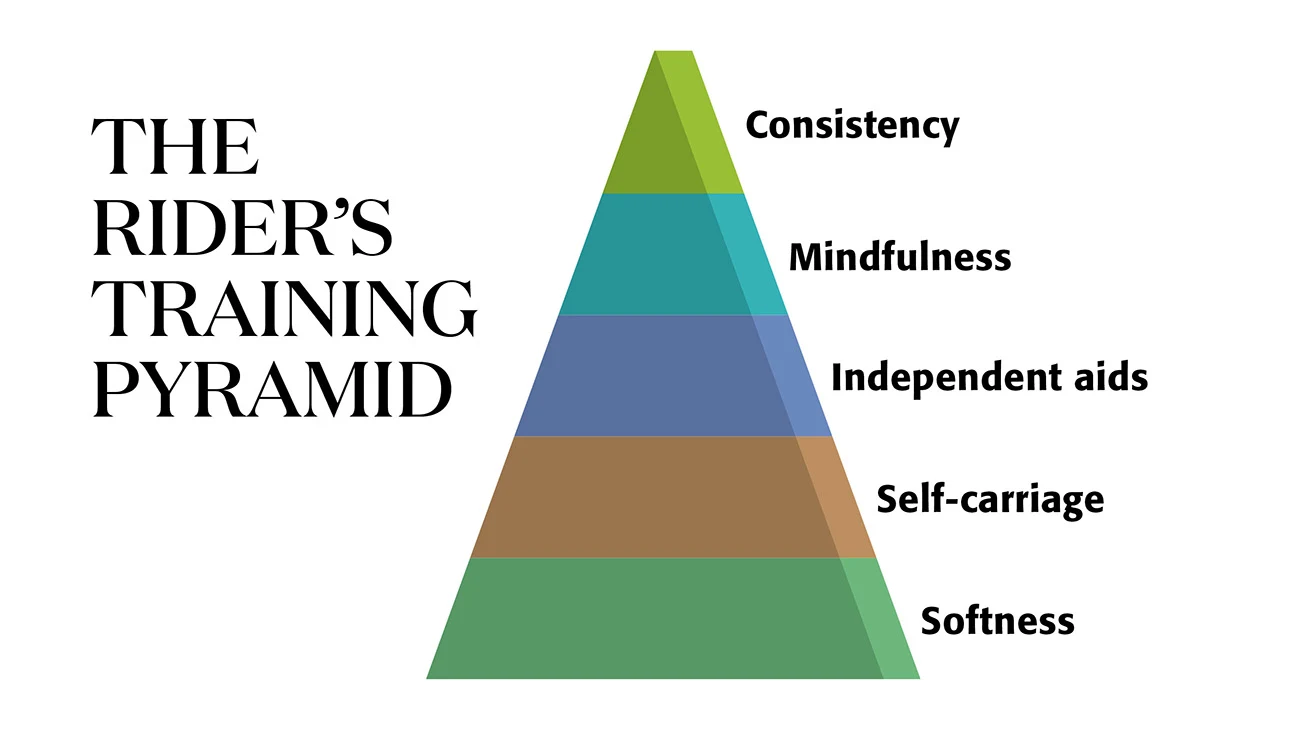Sometimes my team and I are really rolling, with lots of horses and humans showing and getting somewhere and grinding it out. Other times, the youngsters are all youngstering, and I didn’t book a lot of clinics in January and February because the weather usually stinks, and we’re mostly just logging miles and waiting for something to happen. This is one of those times. But it’s meant that I’ve had time—time to go and watch the warmup at the CDIs, time to get caught up on office work, and time to do some continuing education.
One of those opportunities was Lendon Gray’s Training4Teaching program, which offers free lectures by extremely credentialed people about teaching riders, a topic we don’t talk enough about in dressage. (We say lots about horse training, but not enough about human training.) In addition to some great pearls of wisdom from a whole panel of excellent instructors, Lendon also assigned us some homework: to develop a “Rider Training Scale” to mirror that which already exists for training the horse.

The dressage training scale is often drawn visually as a training pyramid, with the notion that one must have the bottom layer under control before moving up in one’s expectations of one’s horse. It begins with rhythm (a horse must move rhythmically and with relaxation before training can begin), followed by suppleness (he can’t have any blockages, so energy can flow freely from hind legs to bridle), contact (you can’t ride a horse from back to front unless you have a front), impulsion (now add giddyup), straightness (giddyup equally right and left, instead of careening around like a Honda Civic on ice), and lastly collection (take all that and gather it).
We can quibble over the minor details, but the training pyramid is pretty darn clear and methodical, and reminds us as we go up the levels that the basics are everything. I have a poster of it in my indoor arena at home, and it really is the base of all good horse training; it keeps us from getting caught up in the levels and the movements, because the “tricks” are easy when the quality and rideability of the basic gait and balance are done well.
ADVERTISEMENT
But what about rider training?
We speak often, my trainer pals and I, about managing rider expectations, and about trying to keep riders rooted in basics even as they go up the levels and get more ambitious. We regularly hear from students, “I want to earn my X medal,” or “I want to ride Y level.” Those are great goals—this isn’t a dig—but it’s important to remember that the journey to those things, just like a horse’s journey up the levels, always comes back to the basics.
So here’s my proposed Rider Training Pyramid, beginning with the bottom rung:
5. Softness: The rider’s ability to follow and not interrupt the horse’s movement. Before we teach a rider to influence a horse’s way of going, we first have to teach them to be OUT of the way.
4. Self-carriage: The rider’s ability to affect their horse without losing balance or leaning on the horse. Once they can follow along, the rider needs to be able to balance themselves independently of what the horse is doing, without having to use the reins or the stirrups to hold themselves on.
ADVERTISEMENT
3. Independent aids: The rider’s ability to use one body part without another firing up another. The rider needs to be able to half-halt with the seat and not grab with the reins at the same time. The rider needs to be able to use her right leg without either using her left too or—something I see a lot—taking off the left. That control is what’s required before a rider can influence a horse with tact.
2. Mindfulness: The rider’s ability to feel what answers the horse has given to the rider’s questions, and then the ability to react effectively—either stop asking if they’ve gotten the correct answer, or correct an incorrect answer. A mindful rider uses the leg to tell the horse “go,” and then instantly evaluates the horse’s answer: if he went, the rider stops asking, and if he didn’t, the rider corrects with clarity.
1. Consistency: The rider’s ability to reproduce good riding and training skills on different types and energies of horse, not just one specific type. Can the person ride educated horses and green horses with equal tact? Can she help an unbalanced horse find balance as well as ride an organized horse in a way that the horse stays organized?
What do you think? What did I miss?
Lauren Sprieser is a USDF gold, silver and bronze medalist with distinction making horses and riders to FEI from her farm in Marshall, Virginia. She’s currently developing The Elvis Syndicate’s C. Cadeau, Clearwater Farm Partners’ Tjornelys Solution, as well as her own string of young horses, with hopes of one day representing the United States in team competition. Follow her on Facebook and Instagram.














